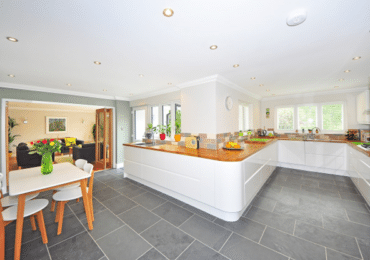Renovating your kitchen breathes new life into your home, and one of the most transformative changes you can make is installing new tiles. Whether aiming for a sleek, modern look or a cozy, rustic feel, tiles can help you achieve the desired atmosphere. However, a successful tile installation requires more than picking out your favorite tiles and sticking them on the wall or floor. Careful measurement and planning are crucial to ensure a smooth and visually pleasing result. This guide takes six essential steps to measure and plan your kitchen tile installation project correctly.

Choose the Right Tiles
Consider factors like color, texture, and material. Porcelain and ceramic tiles are famous for kitchens due to their durability and water resistance. Natural stone tiles like marble or granite can add elegance but require more maintenance. There are also limestone look tiles that offer the appearance of natural stone with less maintenance. If you want a more modern aesthetic, glass tiles can create a sleek and reflective surface. On the other hand, if you’re aiming for a cozy and rustic vibe, consider opting for textured or patterned tiles that add depth and character to your kitchen. Choose tiles that complement your kitchen’s style while being functional for the space.
When choosing the suitable tiles for your kitchen, several factors should be taken into consideration:
- Color and Shade: Select a color that complements your kitchen’s overall aesthetic and existing color palette. Consider whether you want to match or contrast with your cabinets, countertops, and other design elements.
- Texture and Finish: Tiles’ texture affects appearance and functionality. Smooth tiles are easy to clean, while textured tiles provide better slip resistance, making them ideal for kitchen floors.
- Material: Different tile materials have varying levels of durability, maintenance requirements, and aesthetic appeal. Standard options include porcelain, ceramic, natural stone (like marble or granite), glass, and metal.
- Size and Shape: The size and shape of tiles can influence the perceived size of your kitchen. Larger tiles can open a space, while smaller tiles can add intricate detail. Rectangular tiles can elongate a room, while square tiles offer a classic look.
- Pattern and Layout: Decide on a tile layout and pattern that complements your kitchen style. Consider options like straight lay, diagonal, herringbone, or a custom pattern that enhances the overall design.
Considering these factors will help you decide when choosing suitable tiles for your kitchen, ensuring the result looks beautiful and meets your functional and practical needs.
Assess and Plan Your Space
Take a step back and assess your kitchen space. Consider the layout, the existing color scheme, and the overall aesthetic you’re aiming for. Are you installing tiles on the walls, floors, or both? This initial planning phase will help you make informed decisions later on. Additionally, evaluating your kitchen’s traffic flow and functional areas is essential for determining where tiles will have the most significant impact and practicality. This early consideration ensures that your tile installation not only enhances the visual appeal but also seamlessly integrates with the functionality of your kitchen space.
Measure Accurately
Accurate measurements are the foundation of a successful tile installation. Use a tape measure to measure the length and width of the areas you plan to tile. For walls, measure the height as well. Remember that walls and floors might not be perfectly square, so measure at multiple points and note the most extensive measurements. Furthermore, creating a detailed sketch or diagram of the space, accompanied by labeled measurements, can serve as a valuable reference during the tile selection and installation processes. These meticulous measurements and sketches will empower you to proceed confidently with your tile project, minimizing the chances of errors and ensuring a precise and professional outcome.
Calculate Tile Quantity
With measurements in hand, it’s time to calculate the tiles you’ll need. Tiles are typically sold by the square foot, so multiply the length and width of each area to get the square footage. Add a bit extra (usually around 10%) for cutting, mistakes, and future replacements. Also, consider tile patterns – some designs require more wastage due to cuts. Regarding the extra tiles needed for specific patterns or designs, such as diagonal or herringbone layouts, ensure you have a sufficient supply to account for any unexpected adjustments or changes in the installation process. Correctly estimating tile quantity avoids delays and guarantees a polished finish without compromising quality or design.
Plan the Layout
The layout of your tiles can significantly impact the visual appeal of your kitchen. Experiment with different patterns and arrangements before settling on a final design. You can use tile spacers to ensure even gaps between tiles for a professional finish. Start tiling from the center and work your way out to the edges. This way, you’ll avoid having minor, uneven cuts in prominent areas. Using a visual aid like a mock-up or digital design software can provide a clear preview of how your kitchen’s chosen layout will look, allowing you to make informed decisions before the installation begins. Beginning tiling from the center and working outward ensures a balanced and symmetrical appearance. It simplifies aligning tiles with walls and other fixed elements for a seamless and aesthetically pleasing outcome.
Prepare the Surface and Start Tiling
Before tiling:
- Ensure the surface is clean, dry, and smooth.
- Remove any old tiles, adhesive, or paint.
- For new walls or floors, consider using a primer to help the adhesive bond better.
When applying sealant, do it in small sections to prevent it from drying out before you place the tiles. Press each tile firmly into the adhesive, using a slight twisting motion to help it grip. Regularly checking the alignment and using a level as you progress ensures that your tiles stay straight and even, contributing to the overall polished appearance of the installation. Taking your time during this stage and maintaining consistency in adhesive application and tile placement results in a professional finish that elevates the entire aesthetic of your kitchen space.

Embarking on a kitchen tile installation project can be both exciting and overwhelming. However, by following these six essential steps – assessing and planning your space, measuring accurately, calculating tile quantity, choosing the suitable tiles, planning the layout, and preparing the surface – you can ensure a successful and visually pleasing outcome. Proper planning saves you time and money and ensures that your kitchen’s new look will stand the test of time. So, take your time, measure twice, and enjoy the process of transforming your kitchen into a beautiful and functional space.

